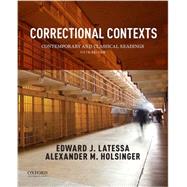A comprehensive and critical review of corrections, Correctional Contexts: Contemporary and Classical Readings, Fifth Edition, traces the history and development of corrections and punishment as it has evolved in the U.S. over the past few centuries. This text presents both classical and contemporary articles that cover the history of corrections in the U.S.; discusses how various facets of the system operate today; and considers where we as a country may be headed regarding the confinement, control, and treatment of our correctional populations. Each chapter opens with an introduction and concludes with study questions.








